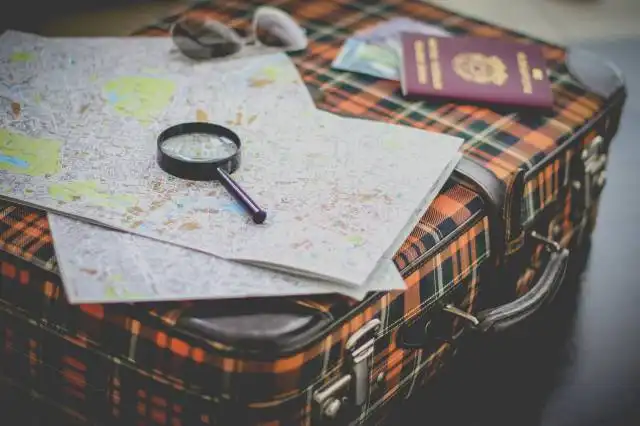Start a Travel Photography Business
Turning Your Passion for Travel and Photography into a Profitable Business Venture
| Updated


TRAVEL PHOTOGRAPHY BUSINESS
Embrace your wanderlust and camera skills with a travel photography business! In this adventurous venture, your office is the whole world filled with diversity- scenic landscapes, exotic cultures, and enchanting wildlife. Essentially, your business would revolve around capturing stunning snapshots from various geographic locations and selling these masterpieces to media companies, travel agencies, magazines, or individuals. This pursuit flawlessly blends thrill and work, keeping that wide grin intact while your business and travel miles clock up simultaneously!
Jump to Business Plan
RELATED BUSINESS IDEAS
Browse ALL Hospitality & Leisure Ventures Business Ideas
Discover Your Perfect Domain
Unlock the door to your online success with our hand-picked selection of premium domain names. Whether you're starting a new venture or rebranding an existing one, the right domain can set the tone for your digital presence. Browse through our curated list, each with its unique potential to enhance your brand's visibility and credibility.
TRAVEL PHOTOGRAPHY MINI BUSINESS PLAN
This a quick reality check to help you identify the strengths and weaknesses of your business concept before you dive in.
Expected Percent Margins:
- Gross Margin: 60-70% (After deducting the cost of the photo sessions, travel, and photographic equipment)
- Net Profit Margin: 20-30% (After including all business operation costs)
Earnings Expectations:
- Daily Earnings: $400 - $1,000 (Based on 1-2 photo sessions per day)
- Weekly Earnings: $2,800 - $7,000
- Monthly Earnings: $12,000 - $30,000
- Annual Earnings: $144,000 - $360,000
Actions To Hit Those Numbers:
Initial Investment:
- Equipment: Buy a professional camera, lenses, tripods, filters, and other necessary photography equipment.
- Travel Costs: Schedule trips in advance and work with travel agents or airlines to get discounted tickets.
- Insurance: Insure your gear as it's a costly investment.
Marketing and Customer Acquisition:
- Social Media Advertising: Post your work on Instagram, Facebook, and Pinterest.
- Website and SEO: Create a website to showcase your portfolio. Use search engine optimization to rank higher in search engine results.
- Collaborations: Collaborate with travel bloggers, influencers, and tourism organizations to get exposure.
Sales and Customer Experience:
- Photography skills: Attend workshops/courses to improve your skills. Specialize in a type of travel photography.
- Packages: Offer various packages to clients based on the number of photos, locations, and editing requirements.
Cost Control:
- Negotiate: Always negotiate travel and accommodation costs.
- Used Equipment: Consider buying used equipment from reliable sources.
Remember, these are only estimates. Real earnings can vary based on your skills, location, and market trends. Always do a feasibility analysis before starting a business.
NOT WHAT YOU HAD IN MIND? Here are more ideas



Browse ALL Hospitality & Leisure Ventures Business Ideas
Grab Your Business Website Name
Before you get caught up in the whirlwind of setting up your business, invest in a domain name. It's a small but significant step that lays the foundation for your brand and makes it easier for customers to find and trust you. Just like you wouldn't build a house without securing the land first, don't build a business without securing your domain name.
"Why? Can't that wait?" Here's why it shouldn't
Step 1: Determining if a Travel Photography Business is Right for You
Breakdown of Startup Expenses
Before starting a travel photography business, it is important to consider the startup costs associated with the venture. These costs can include the purchase of a camera and lenses, a computer, software, and other equipment. Additionally, you may need to purchase a domain name and hosting for your website, as well as any business licenses or permits that are required in your area. It is important to research the costs associated with each of these items and create a budget for your business.
Breakdown of Ongoing Expenses
After you have considered the startup costs associated with your business, it is important to consider the ongoing expenses. These can include the cost of travel, lodging, food, and other expenses associated with taking pictures. Additionally, you may need to pay for advertising, marketing, and other services to help promote your business. It is important to create a budget for these expenses and to track your spending to ensure that you are staying within your budget.
Examples of Ways to Make Money
There are many ways to make money with a travel photography business. You can sell prints of your photos, offer photography services to clients, or create stock photography for websites and magazines. Additionally, you can create a blog or website to showcase your work and offer tutorials or courses to help others learn photography. You can also create an online store to sell prints, books, and other products related to photography.
Step 2: Naming the Business
When it comes to naming your travel photography business, it is important to choose a name that is memorable and reflects the type of photography you do. It is also important to make sure that the name is not already taken. Here are some tips for choosing a name:
Brainstorm: Take some time to brainstorm potential names for your business. Think of words that evoke the feeling of travel and photography. Also, consider using puns or alliteration to make the name more memorable.
Research: Once you have a few potential names, it is important to do some research to make sure that the name is not already taken. Search online to see if the name is already in use by another business.
Test: Once you have narrowed down your list of potential names, it is important to test them out. Ask friends and family for their opinion on the names and see which one resonates the most.
Finalize: Once you have chosen a name, it is important to make sure it is legally available. Check with your local government to make sure the name is not already taken. Once you have finalized your name, you can start to create a logo and branding for your business.
Step 3: Setting Up a Business Plan
Outlining Goals
When setting up a business plan, it is important to outline your goals. These goals should be realistic and achievable. Consider what you want to accomplish with your travel photography business. Do you want to make a certain amount of money? Do you want to be able to travel to certain places? Do you want to be able to work with certain clients? All of these goals should be taken into consideration when setting up your business plan.
Establishing a Budget
After you have outlined your goals, it is important to establish a budget. This will help you to determine how much money you need to start your business. Consider the cost of equipment, travel expenses, and any other costs associated with running your business. You should also consider the cost of marketing and advertising. Once you have established a budget, you can begin to plan how you will fund your business. Consider taking out a loan, using savings, or seeking investors. Having a budget in place will help you to stay on track and keep your business running smoothly.
Step 4: Obtaining Necessary Licenses and Permits
Researching Local Regulations
Before applying for any licenses or permits, it is important to research the local regulations in the area where the business will be located. This includes researching any local laws or regulations that may apply to a travel photography business. Additionally, it is important to research any local taxes that may be applicable to the business. It is important to be aware of any potential fees or taxes that may be required in order to legally operate the business.
Applying for Licenses and Permits
Once the local regulations and taxes have been researched, the next step is to apply for any necessary licenses and permits. Depending on the location, this may include a business license, a photography license, or other types of permits. Additionally, it may be necessary to obtain a sales tax permit or a special permit for selling photographs. It is important to ensure that all necessary licenses and permits are obtained before beginning to operate the business.
Once the licenses and permits have been obtained, the next step is to create a business plan. This should include a detailed outline of the business’s goals, objectives, and strategies. Additionally, it should include a financial plan that outlines the expected costs and revenues of the business. This plan should also include a marketing plan that outlines how the business will reach potential customers. Finally, the business plan should include a risk management plan that outlines how the business will handle any potential risks.
Step 5: Setting Up a Business Location
Researching Potential Locations
When researching potential locations for a travel photography business, it is important to consider the cost of rent, the size of the space, and the location’s proximity to potential customers. It is also important to consider the local laws and regulations that may affect the business. For example, some cities may require a business license or permit to operate a business. Additionally, it is important to consider the amount of foot traffic the location receives, as this can have a significant impact on the success of the business.
Securing a Business Location
Once the business owner has identified a potential location, they should contact the owner or landlord of the space to discuss the terms of the lease. It is important to negotiate a fair rental rate and to ensure that the lease includes all of the necessary provisions to protect the business. Additionally, the business owner should consider the cost of any necessary renovations or improvements to the space. Finally, the business owner should obtain the necessary permits and licenses to operate the business in the chosen location.
Step 6: Purchasing Necessary Equipment
List of Necessary Equipment
When starting a travel photography business, there are certain pieces of equipment that are necessary for success. This includes a digital camera, lenses, a tripod, a laptop, and a storage device. Additionally, depending on the type of photography you plan to do, you may need to purchase additional equipment such as a drone, a light kit, and a flash.
Tips for Purchasing Equipment
When purchasing equipment for your travel photography business, it is important to research the best options for your budget and needs. Consider purchasing used equipment to save money, and look for deals on refurbished items. Additionally, it is important to purchase the best quality equipment you can afford, as this will help you produce the best quality images. Finally, it is important to purchase equipment that is lightweight and easy to transport, as you will be taking it with you on your travels.
Step 7: Creating a Website
Creating a website is essential for any business, and travel photography is no exception. A website will allow potential customers to find out more about your services, view your portfolio, and contact you for bookings. When designing your website, it is important to keep the design simple and easy to navigate. Make sure to include a portfolio page, contact page, and a blog page. Additionally, make sure to include a call-to-action on each page, such as a “Book Now” button or a “Contact Us” form.
Tips for Optimizing Your Website
In addition to designing a website, it is important to optimize your website for search engines. This will help your website show up in search engine results when potential customers are looking for travel photography services. To optimize your website, include keywords related to your services throughout the website, such as “travel photography” or “vacation photos”. Additionally, make sure to include meta descriptions and titles for each page, as well as internal and external links. Finally, make sure to submit your website to search engines, such as Google and Bing.
Step 8: Promoting the Business
Promotion is key to the success of any business, and travel photography businesses are no exception. To get the word out about your business, you should consider a variety of promotion strategies. Examples of promotion strategies include:
Social media: Creating a presence on social media sites such as Facebook, Instagram, and Twitter can help you reach a wider audience and build relationships with potential customers. You can also use social media to showcase your work and share tips and advice with your followers.
Networking: Networking with other photographers, travel bloggers, and tourism professionals can help you get your name out there and make valuable connections. You can attend industry events, join online forums, and participate in local photography meetups.
Advertising: Advertising your business in local newspapers, magazines, and online can help you reach potential customers. You can also consider running targeted ads on social media platforms.
Collaborations: Collaborating with other photographers and travel bloggers can help you reach a wider audience and gain more exposure for your business. You can offer to do joint projects or offer discounts to those who promote your business.
Word of mouth: Word of mouth is one of the most effective forms of promotion. Encourage your customers to share their experiences with your business and ask them to refer you to their friends and family.
Step 9: Networking
Networking is an important part of any business, and travel photography is no exception. There are a variety of ways to network, such as attending photography conventions, joining photography clubs, and joining online photography forums. Additionally, photographers can join local business groups and chambers of commerce to network with other business owners and potential clients.
Benefits of Networking
Networking can be beneficial in a number of ways. It can help photographers make connections with other photographers, potential clients, and other business owners. Additionally, networking can help photographers build their reputation and credibility, as well as help them find new opportunities for their business. Networking can also help photographers stay up to date on the latest trends in the industry and learn from other photographers’ experiences.
Tips for Networking
When networking, it is important to be professional and courteous. Photographers should dress appropriately and bring business cards to any networking event. Additionally, photographers should be prepared to talk about their business and the services they offer. It is also important to be open to new opportunities and to listen to what other photographers have to say. Finally, photographers should follow up with any contacts they make and keep in touch with them.
EXPLORE MORE CATEGORIES
Browse ALL Business Idea Categories
TAKE THE NEXT STEPS









